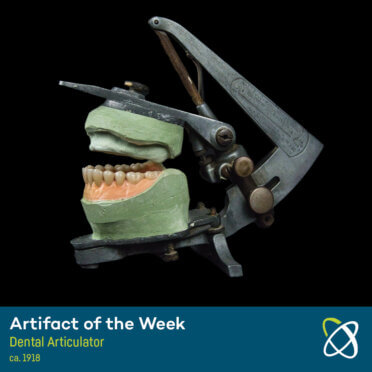Dental Articulator – ca. 1918
This odd-looking device is the Monson Mandibulo-Maxillary Instrument, designed by George Monson, an orthodontist from Minneapolis. It is a dental articulator meant to mechanically duplicate the natural movement of the mandible, or lower jawbone, and to simulate how it lines up with the maxillary, or upper jawbone.

The Monson Mandibulo-Maxillary Instrument was based on George Monson’s theory of spherical mandibular movement, that the mandibular (lower) teeth move over the maxillary (upper) teeth like over the surface of a sphere. He proposed that the mandibular teeth should be arranged to close around a sphere of 4-inch radius, and that cuspal guidance is more influential to how the jaw moves than the temporomandibular joint (TMJ) which acts like a sliding hinge connecting your jawbone to your skull.
Cuspal guidance is how your jaw moves based on how the cusps of your teeth line up when your mouth closes. The cusp is the pointed or rounded projection on the chewing surface of the tooth. If the top and bottom teeth line up with the cusps coming together like a zipper, then the jaw has smooth up and down movement. If the cusps do not line up, then the jaw must move up and down AND side to side to come fully together. Understanding how the jaw works helps dentists and orthodontists understand how the teeth of an individual are going to fit together in order to create dentures or other orthodontic devices.
See more Artifacts of the Week
Artifact of the Month Video Series
Connect with curiosity!










